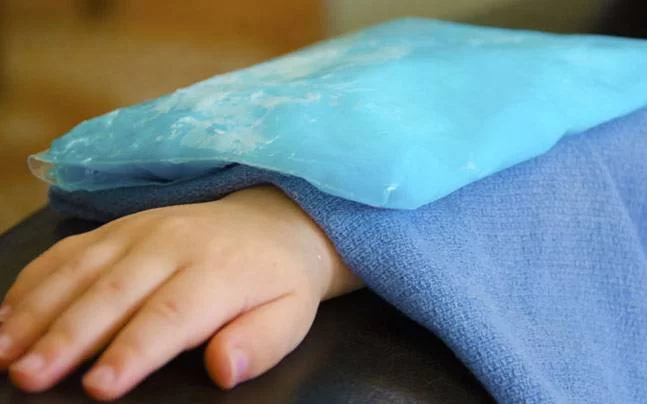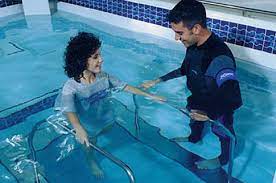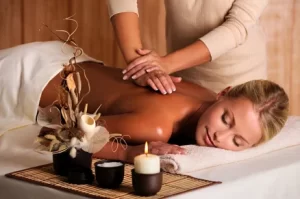Cryotherapy
Table of Contents
Definition
Cryotherapy also called ice application, is the easiest and ancientest method to treat injuries. It’s globally used to spread because of its effectiveness, convenience, low cost, and ease of transportation. Ice is supposed to control pain by instigating local anesthesia. It also reduces edema, nerve conduction velocities, cellular metabolism, and local blood circulation.
The result of cryotherapy relay on the method being used, the duration, the temperature of the ice, and how deep the subcutaneous fat is.
Lewis Hunting Reaction
The Lewis hunting reaction or hunting response is alternating vasoconstriction followed by vasodilation exposed to the cold to the extremities. The term Lewis reaction is also used after Thomas Lewis, who first explained the effect in 1930.
Vasoconstriction ensues first to lower the heat loss but also results in strong cooling of the part of the extremities. About five to ten minutes later begin cold exposure, and the blood vessels in the extremities will shorty vasodilate. This is probably operated by a sudden descent in the secretion of neurotransmitters from the sympathetic nerves to the muscular coat of the arteriovenous anastomoses because of the local cold. This cold-induced vasodilation enhances blood flow and after that the temperature of the digits.
A new stage of vasoconstriction follows vasodilation, after which the procedure recites. Vasodilation can be cold-induced next to early termination of vasoconstriction when the cold is maintained for more than 15 minutes or when the temperature is lowered below 10 degrees Celsius.
Application Methods
Ice Packs
- It is the most typical method of cryotherapy. There are distinct types of ice used in ice packs. The most typical types are ice packs made with cubed, crushed, and wetted ice.
- It was discovered that wetted ice is more suitable to lower surface temperature during treatment and maintain the lower temperature during recovery. It is also better effective in lowering the intramuscular temperature during treatment.
- Ice packs being used for muscle strain such as Hamstring strain
Ice Spray
- A cooling effect can also be delivered by icing spray for a similar effect.
Immersion
- Easy or whirlpool immersion.
Ice Massage
- More currently entire-body cryotherapy has become famous for athletes, to help aid recovery, as well as in persistent pain patients such with rheumatological conditions. More study is required to understand the effect on the body and its relation to pain.
- Gentle and slow strokes in a circular direction for around five-ten minutes.
Indication
- Acute soft tissue injuries for example ankle sprain, muscular sprain, ligament sprain
- Myofascial trigger points
- Tendinitis
- Acute swelling
- Bursitis
- Post-orthopedic surgery such as TKR, ACL reconstruction, and arthroscopic shoulder surgery.
- Acute sports injuries
- DOMS
Pros
- Pain relief
- Swelling reduction
- Decreased surface temperature
- Effective on a broad range of soft tissue injuries
Cons
- Small proof regarding the duration and commonness of treatment to be effective
- Compression has been demonstrated to be more useful postoperatively
- In some cases, bradycardia and frostbite clinical presentation have been observed.
- Few more refined cryotherapy devices may decrease the range of movement following TKR due to the immobilization of the joint.
Possible Risks factors
Inhibit Muscle Function
- Cooling can temporarily Inhibit muscle function with the possibility for enhanced risk of injury or re-injury
- Be careful when having patients bear weight or undertake complicated exercises after icing a lower limb
Ice Burn
An elder individual with impaired sensation and or insufficient circulation will be more prone to an ice burn, thus consider using less intense icing techniques (for example a moderate ice pack covered in an insulating layer of towel or cloth)
- The younger individuals with fair sensation and circulation may aid most from the direct immersion of the limb in cold water and then progressively adding ice cubes
- Cold gel packs held in a freezer have a surface temperature below 0-degree celsius (32°F) and thus an insulating layer must be used between the cold pack and the patient’s skin
Cryotherapy-Induced Nerve Injuries
- Most typically when cold is given in combination with compression
- Check capillary refill while the application of ice combined with compression therapy to secure adequate blood circulation
Generalized Cooling and Decrease in Core Temperature
- Shivering and piloerection are indications of a decrease in core temperature which may compromise individual safeness (particularly in the geriatric and those with fever)
- The application of therapeutic cryotherapy must produce simple local effects.
Decreased ROM
Ice may donate to the contracting of collagen fibers in the connective tissue
- After achieving ROM by warming, stretching, and then strengthening in the newest part of the ROM, it is likely inadequate to cool the tissue in a shortened position
- If one expects to cool the tissue post-stretch and exercise, it is best to do so with the tissue in a lengthened position
- In individuals with extremely limited ROM due to the tissue of the scar, it may be preferable not to use ice.
Contraindications
Conditions in which icing is contraindicated
- CRPS, hemoglobinuria, cryoglobulinemia,
- Peripheral vascular disease
- Impaired circulation such as Raynaud’s disease
- Urticaria
- Hypersensitivity to cold
- Skin anesthesia
Benefits
Relieve migraine symptoms
Cryotherapy can assist to treat migraines by cooling and numbing nerves in the neck region. One study discovered that applying a neck wrap including two ice packs to the carotid arteries in the neck significantly relieved migraine pain in those tested. It’s thought that this operates by cooling the blood passing via intracranial vessels. The carotid arteries are near the skin’s surface and attainable.
Numbs nerve irritation
Many athletes used an ice pack to treat acute injuries for years, and one of the reasons why is that it may numbness pain. The cold may numb an irritated nerve. Doctors will treat the affected region with a small probe inserted into the nearby tissue. This can assist to treat pinched nerves or neuromas, chronic pain, or also acute traumas too.
Aids to treat mood disorders
The extreme cold temperatures in full-body cryotherapy can result in physiological hormonal reactions. This includes the release of noradrenaline, adrenaline, and endorphins. This may have a desirable effect on those mourning from mood disorders such as nervousness and depression. One investigation discovered that full-body cryotherapy was useful in short-term therapy for both.
Reduces arthritic pain
Localized cryotherapy therapy isn’t the sole thing that’s effective at dealing with severe conditions; one study found that complete body cryotherapy significantly decreased pain in people with arthritis. They found that the therapy was well-tolerated. It also permitted more aggressive physiotherapy and occupational therapy an outcome. This eventually made rehabilitation programs more useful.
Can assist to treat low-risk tumors
Targeted, cryotherapy can be used as a cancer therapy. In this context, it’s understood as “cryosurgery.” It operates by freezing the cancer cells and nearby them with ice crystals. It’s presently being used to treat a few low-risk tumors for specific types of cancer, including prostate cancer.
Can help avoid dementia and Alzheimer’s disease
During research is required to estimate the effectiveness of this strategy, it’s theorized that full-body cryotherapy can help avoid Alzheimer’s and different types of dementia. It’s thought that this can be an effective treatment due to the anti-oxidative and anti-inflammatory results of cryotherapy can help battle the inflammatory and oxidative stress responses that happen with Alzheimer’s.
Treats atopic dermatitis and further skin diseases
Atopic dermatitis is a chronic inflammatory skin disease with the characteristic manifestation of dry and scratchy skin. Ice packs can improve antioxidant levels in the blood and also reduces inflammation, it makes sense that both localized and full-body cryotherapy can aid to treat atopic skin disease. Another analysis (in mice) studied its effect on acne, targeting the sebaceous glands.
Risks and side effects
- The most characteristic side effects of any sort of cryotherapy are feeling of numbness, paresthesia, redness, and irritation of the skin. These side effects are nearly always transient. Make a meeting with your doctor if they don’t fix this within 24 hours.
- U must never use cryotherapy for longer than is suggested for the form of therapy you’re using. For full-body cryotherapy, this would be more than 4 minutes. If you’re using an ice pack or ice bath at the house, you must never apply ice to the region for more than 20 minutes. Cover ice packs in a towel so you don’t injure your skin.
- Those with diabetes or any diseases that affect their nerves must not use cryotherapy. They can be incapable of fully feeling its effect, which could result in further nerve damage.
FAQ
You’ll know when you’ve had a cold on long enough, by monitoring the four phases of cold treatment: The first phase is an uncomfortable feeling; the second phase is a stinging sensation; the third phase is burning or aching; the fourth phase is numbness. It takes five to fifteen minutes to reach all four phases.
Cryotherapy is the use of intense cold to freeze and remove abnormal tissue. Doctors use it to treat many skin pathology (concerning warts and skin tags) and a few cancers, implicating prostate, cervical, and liver cancer. This therapy is also named cryoablation.
Cryotherapy is the use of cold in the treatment of acute and sub-acute damage as well as to reduce pain after athletic renovation. The characteristic cryotherapy points used in rehabilitation possess ice packs, and ice massage; used isolated or in combination with the electrical currents results.
Directly after therapy, pain and swelling may happen for one to two hours. The treated area then shades (brown, brown-red, or even blue) within 24 – 48 hours. If the freezing was comprehensive enough, a blister (or blood blister) can develop. If blistering is extreme, the region can weep for various days.
Cryotherapy warms your body, shrinks pores, and drives blood circulation to the surface of your skin. Blood and lymph circulation, two of the most significant things in your body, are greatly influenced by cryotherapy. The process also flushes toxins, for example, lactic acid, to assist stimulate healing.








23 Comments